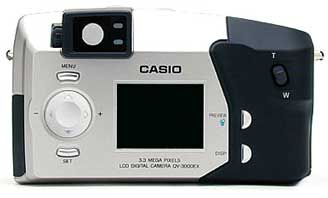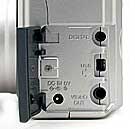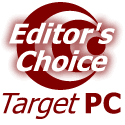Changing sides to the back panel, you see most of the options used for configurations.
The most attractive part of this specific side is the color 1.8" LCD
display. This will be used for virtually all the configurations of the
3000EX. On the top left, we see the Zoom Lever; this controls the optical
zoom. A little bit lower, the preview button is present, depending in what
mode you are, this may let you preview your last captured picture or if you
are in the playback mode you can delete on-screen images. Lower, the display
button is present; this gives you the option to turn the LCD display off.
Going to the top left, we see the menu button, this brings different
menu panels. Lower the display button, you find the Toggle button;
this lets you navigate through the menu and gives different scrolling options
in some specific modes. At last, a little bit lower is the set button; this
acts as confirmation button.
 |
|
Back
View
|
Changing sides to the right, we notice
all the input/output ports. First is the digital, USB and video out jacks.
Following is the DC jack; you can connect an optional 6V DC adapter to it.
The left side features the input slot for the memory card. The Bottom
features a plastic tripod mount and a battery compartment hosting four AA
batteries. An AC adapter is available as an option.
 |
|
Bottom
View
|
 |
|
I/O
Panel
|
Storage
 Casio offers two
different versions of the 3000 camera, first is the standard EX version and
the 3000 Plus. Both models are identical in specifications and features; what
lies between both is their storage. Our 3000EX sample features a standard 16MB
card compared to the Plus version that features the IBM MicroDrive with 340
Megabytes. This is quite an improvement. The Plus version retails at only 200$
USD more. This will be something to consider for the bigger photo amateurs.
A standalone IBM microdrive retails at around 400$USD, and by purchasing the
Plus version over the EX you save 200$ for the MicroDrive Purchase. Another
aspect touching the storage that is worth mentioning is that the 3000EX organizes
data (pictures) into storage folders, assigned by numbers from 100 – 998. Each
folder can host up to 100 files.
Casio offers two
different versions of the 3000 camera, first is the standard EX version and
the 3000 Plus. Both models are identical in specifications and features; what
lies between both is their storage. Our 3000EX sample features a standard 16MB
card compared to the Plus version that features the IBM MicroDrive with 340
Megabytes. This is quite an improvement. The Plus version retails at only 200$
USD more. This will be something to consider for the bigger photo amateurs.
A standalone IBM microdrive retails at around 400$USD, and by purchasing the
Plus version over the EX you save 200$ for the MicroDrive Purchase. Another
aspect touching the storage that is worth mentioning is that the 3000EX organizes
data (pictures) into storage folders, assigned by numbers from 100 – 998. Each
folder can host up to 100 files.
Shots of the menu
Bonus Pack
Casio included Photo Loader for use with Windows 95/98, NT4.0 and Macintosh.
This application automatically transfers images from the camera or from an
optional CompactFlash reader to your PC by using the USB interface. HTML files
are used to speed up the image search. Panorama Editor is for use with Windows
95/98 and NT4. It lets you to store a panorama image in JPEG (one wide image)
or QTVR (A quick time movie that allows the image to be scrolled left or right
on the PC). QuickTime3 is for use with Windows 95/98, NT4.0, and Macintosh.
It permits you to view QuickTime movies you create with the Panorama Editor.
Manual PDF File Converter converts your images to a PDF file. A PDF is a small
file that is easy to e-mail and print.
Conclusion
Casio has done a nice job on its QV-3000EX
camera. Employing the most advanced 3.34 megapixel CCD without any major price
lifts easily putts Casio in the high-end digital market that the home user
or high end photo amateur can afford. The QV-3000 also features
primary color filters to create 2048 x 1536-pixel images of high-definition
and natural looking colors. In addition it uses a F2.0 Canon 3X optical zoom
and a wide-aperture lens. Most power users that are currently seeking for
a digital solution in the 800$ USD price ranges should without Doubts look
at Casio's latest offerings. We were pleased to see Casio include full documentation
on the installation process and a big guide covering the functions of the
product it self. The documentation is clear and will not confuse the first
timer.
